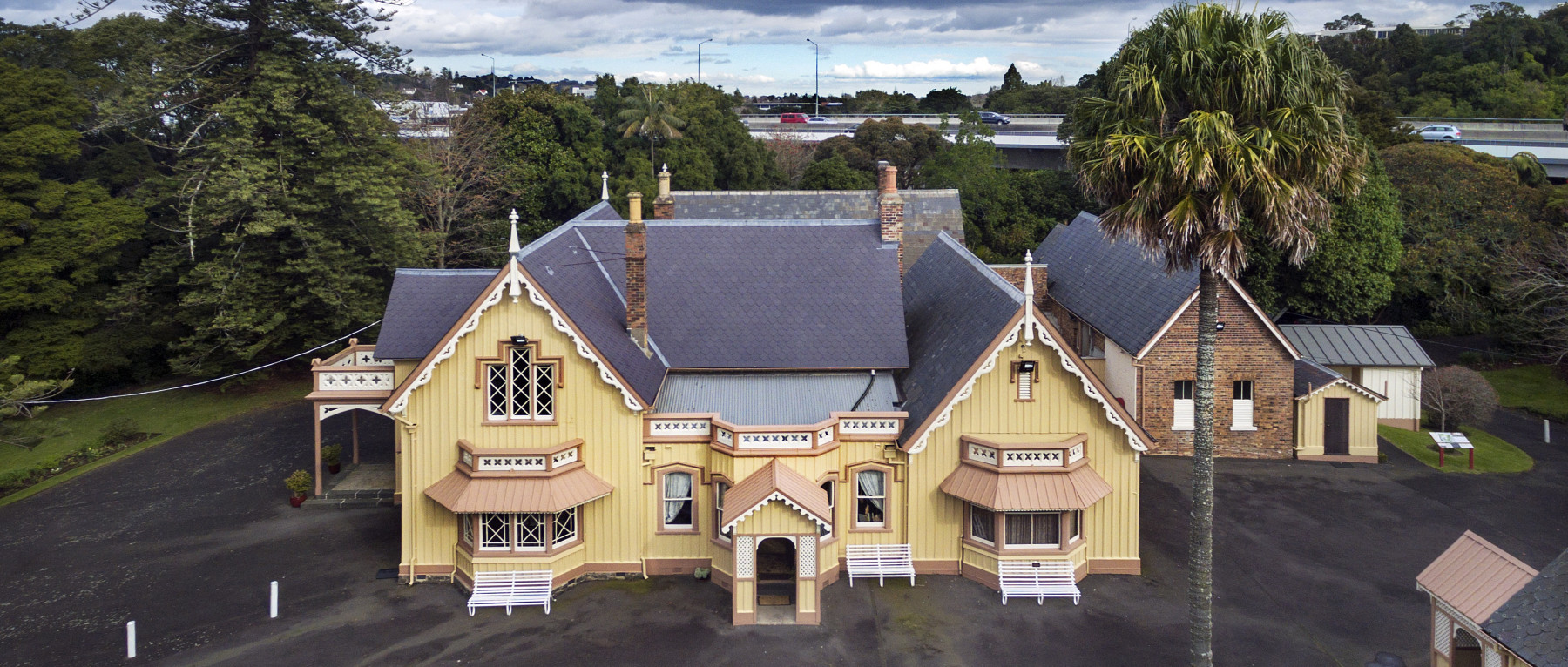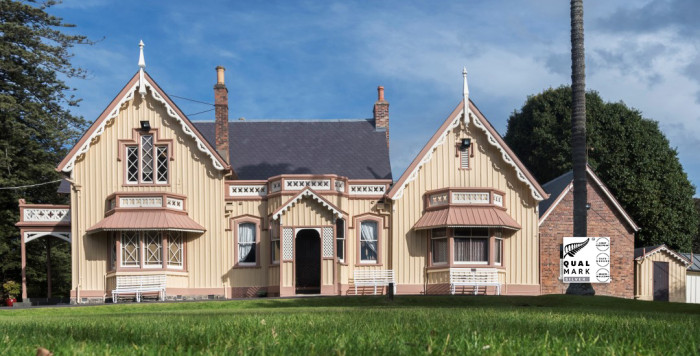An introduction to Highwic
Perched above Newmarket’s bustling commercial strip, Highwic is an island of Victorian heritage calm surrounded by a beautiful heritage garden and orchard. It’s also a fascinating place for anyone who wants an insight into well-to-do colonial domestic life.
Stepping into the sprawling Newmarket home of Alfred Buckland, first wife Eliza and then, second wife Matilda during the 1880s would have been a lively experience. Kids everywhere, of all ages. Noisy games. And dolls and toys scattered, mostly on the ‘Children’s Landing’ between the boys’ and girls’ sleeping quarters. With 21 children to Alfred’s name, there was nothing dull about this Victorian family home.
There was much that was handsome, though. Anyone who has watched the TV adaptation of The Luminaries will recognise Highwic’s rich kauri-panelled sitting room from scenes of the atmospheric ‘Matterhorn Hotel’.

Photo: Grant Sheehan
Built in 1862 – but by no means finished then – the house is a rare instance in Aotearoa New Zealand of Carpenter Gothic architecture, a style associated with America’s East Coast, reflecting Alfred’s enthusiasm for the New World. He had good reason to be enthusiastic: arriving from Devon in 1850 as an immigrant of modest means, by 1862 Aotearoa New Zealand had made him a wealthy man, with a successful livestock auctioneering business, saleyards in several provincial towns and property interests.
Which was just as well, because the family kept growing. His first wife Eliza had been heavily pregnant with their first child on the ship, and gave birth within a month of arriving in Tāmaki Makaurau/Auckland. They had seven daughters and three sons in quick succession before her untimely death, just four years after moving into the new house. Before she died, Eliza urged Alfred to find a new wife, suggesting her 19-year-old live-in companion Matilda Frodsham, so their children would have a mother. The following year he married Matilda, with whom he subsequently had another seven daughters and four sons.
The house, which was continuously occupied by descendants of the family until it was bought by the Historic Places Trust (now Heritage New Zealand Pouhere Taonga) and Auckland City Council in the late 1970s, has been set up to reflect its busiest, most populated period, the 1880s. As you stroll through its rooms, all of which are ‘dressed’ with the Bucklands’ original furnishings, along with art and household items of the period, you’ll experience Highwic not as a museum but as a life-filled home, where everyone has just shot off to Saturday sports, friends’ houses and the shops.
On the Children’s Landing, for example, you’ll find the Bucklands’ Victorian toys, including a whirly-twirly doll that originally belonged to Alfred and Matilda’s third daughter, Florence. In the kitchen, the heart of the home, the coal range is still in working order. Visit in winter and you may find volunteers baking ginger gems, scones and slices, all from Matilda’s recipe book. Don’t miss the wonderful morning room on the east side of the house, where the lady of the house wrote her correspondence and received visitors.
Highwic is a grand home, in the sense it’s very large, notably ornate, and comes complete with a drawing room and a number of outbuildings, including a stables, fernery and a detached billiards house – Alfred’s man cave. But Highwic is not as prim and proper as it sounds. Our staff say many visitors feel a strong sense of connection with the home’s vanished occupants. “Often people will look at the equipment in the kitchen and say ‘Oh, my grandmother had one of those. It feels relatable.”
Photo: Heritage New Zealand Pouhere Taonga
Highwic is managed as a living part of the community. In winter, the fire is occasionally lit in the billiard house for ‘craft-er-noons’ of crochet, knitting, embroidery and patchwork-making. In the summer, the house hosts lawn parties and weddings, and visitors lay picnic rugs on the croquet lawn. During school holidays, children can get involved in toy-making, Victorian games and scavenger hunts around the house.
It's a similar story with Highwic’s grounds. You could happily spend an hour meandering through the former orchard, now a pasture painting created by a local primary school, the Whimsical Garden and Lovers’ Walk. But this is not just some pretty Victorian showpiece, it’s a working garden, with beehives among the fruit trees. Highwic plays a role in efforts to make Tāmaki Makaurau/Auckland a more sustainable city, being a spray-free biological pollinator sanctuary and community composting hub. Local school children often visit to learn about sustainability and biodiversity. In 2019 seedlings originating from a landmark Newmark cabbage tree that once stood near the present-day Westfield mall were planted near Highwic’s gate (Mortimer Pass entrance). The tree held great significance to local Māori who called the Newmarket area Te Tī Tūtahi (the cabbage tree stands alone).
Linger at the gift shop, which is full of items that reflect the house: retro toys, and jars of Highwic-made honey. In December, a pop-up Christmas shop sells decorations and gifts, and Highwic hosts a public Christmas garden party.
When you’ve finished exploring, stretch your legs with a walk to the summit of nearby Maungawhau/Mt Eden. The ascent of mainland Tāmaki Makaurau/Auckland’s highest volcano is well worth the effort for the sight of its deep, grassed crater and the views of the city and harbour. On the way, stop at Eden Garden, on the volcano’s eastern slopes. Built over decades on the site of an abandoned quarry, this is a 5.5-acre labour of love, magnificent in spring when the Taiwanese cherries are heavy with blossom and thousands of tulips start to bloom. If you fancy mixing heritage and exercise, head to The Olympic in Newmarket, the first 50-metre swimming pool in Aotearoa New Zealand that dates back to 1939.

